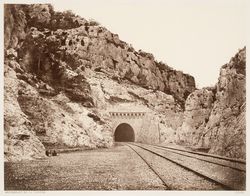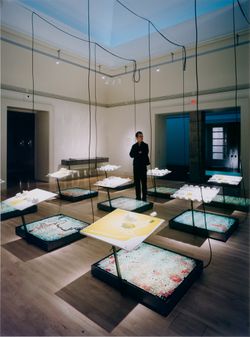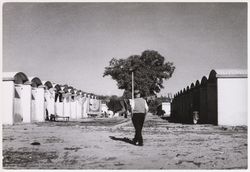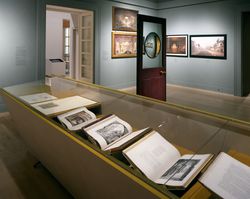Projet
AP018.S1.1982.PR19
Description:
This project series documents the design and construction of the Hôtel de la Délégation in Algiers, Algeria from 1982-1985. The office identified the project number as 8220. This hotel was designed with inspiration from traditional Maghrebian and Middle Eastern architecture but made in the modern style. The site for the project consisted of the hotel, a neighbouring villa, a separate office complex, a roundabout at the entrance, two pools, tennis courts, gardens and, an arcade. The project proposed several variations on the design for the hotel, including an eight-level option and a ten-level option, the latter adding two levels of parking to the bottom of the building. The hotel was built into a hill so floors that were subterranean on one side of the building were above ground on the other. This latter side had terraced pergolas at every level with views over the pool. The hotel had a multi-level atrium that contained elaborate indoor gardens and trees. While the ground floor was made up of conference rooms, banquet halls and the reception area, the other levels mostly contained hotel rooms. This project was commissioned by Lavalin International Inc. for the Algerian government, who are referred to in the records as the Présidence de la République, République Algérienne, Démocratique et Populaire. The project is also referred to as Hôtel Alger in the project documentation. The project is recorded through drawings, photographic materials and textual records dating from 1982-1985. Almost all of the records are in French, with the exception of a few interoffice communications. While there are construction drawings in the project materials, there are also a large number of design drawings showing different schemes and ideas for the hotel. The photographic materials include construction progress photos of the hotel. The textual records consist of correspondence, meeting reports, pre-design records and the project scope, financial documentation, schedules, interoffice letters, construction and detail planning records, specifications and progress reports. Box AP018.S1.1982.PR19.041 in this project series includes an index to the textual materials, which was created by the office.
1982-1985
Hôtel de la Délégation, Algiers, Algeria (1982-1985)
Actions:
AP018.S1.1982.PR19
Description:
This project series documents the design and construction of the Hôtel de la Délégation in Algiers, Algeria from 1982-1985. The office identified the project number as 8220. This hotel was designed with inspiration from traditional Maghrebian and Middle Eastern architecture but made in the modern style. The site for the project consisted of the hotel, a neighbouring villa, a separate office complex, a roundabout at the entrance, two pools, tennis courts, gardens and, an arcade. The project proposed several variations on the design for the hotel, including an eight-level option and a ten-level option, the latter adding two levels of parking to the bottom of the building. The hotel was built into a hill so floors that were subterranean on one side of the building were above ground on the other. This latter side had terraced pergolas at every level with views over the pool. The hotel had a multi-level atrium that contained elaborate indoor gardens and trees. While the ground floor was made up of conference rooms, banquet halls and the reception area, the other levels mostly contained hotel rooms. This project was commissioned by Lavalin International Inc. for the Algerian government, who are referred to in the records as the Présidence de la République, République Algérienne, Démocratique et Populaire. The project is also referred to as Hôtel Alger in the project documentation. The project is recorded through drawings, photographic materials and textual records dating from 1982-1985. Almost all of the records are in French, with the exception of a few interoffice communications. While there are construction drawings in the project materials, there are also a large number of design drawings showing different schemes and ideas for the hotel. The photographic materials include construction progress photos of the hotel. The textual records consist of correspondence, meeting reports, pre-design records and the project scope, financial documentation, schedules, interoffice letters, construction and detail planning records, specifications and progress reports. Box AP018.S1.1982.PR19.041 in this project series includes an index to the textual materials, which was created by the office.
Project
1982-1985
Projet
AP075.S1.2008.PR02
Description:
Project series documents Cornelia Hahn Oberlander's project for the Inuvik School, later known as East Three School, in Inuvik, Northwest Territories. The project consisted in the landscape design and a playground design for the new school replacing the Sir Alexander MacKenzie elementary school and the Samuel Herne Secondary School. Oberlander worked on this project from 2008 to 2012 with architects Pin/Taylor. During her design process, Oberlander consulted the teachers, parents, staff and students on ways to express their culture in the landscape design. She also had to adapt her design to the extreme climate of the region. Oberlander located the play court at the angle of the two buildings of the elementary school and the secondary school, to shelter it from the wind, and allowing small children to play outside. The plant selection was made by "harvesting local site and surrounding area for plant material" [1] and was also inspired by traditional cuisine. The project was completed in 2012. The project series also includes some documents related to a project possibly unrealized of the Jim Koe Park also in Inuvik, near the school. The project series contains design development drawings and working drawings, such as planting plans, irrigation plans, grading plans, landscape sections, and site plans. The drawings also includes sets of building plans used as reference. The project is also documented through correspondence, including with architects, suppliers, and consultants, specifications, scope of work, schematic design and design reports from architectural firm, minutes of meetings, and research material. Source: [1] Herrington, Susan. Cornelia Hahn Oberlander: Making the Modern Landscape, University of Virginia Press, 2014, 304 pages, p. 197.
1999-2014
Inuvik School, Inuvik, Northwest Territories (2008)
Actions:
AP075.S1.2008.PR02
Description:
Project series documents Cornelia Hahn Oberlander's project for the Inuvik School, later known as East Three School, in Inuvik, Northwest Territories. The project consisted in the landscape design and a playground design for the new school replacing the Sir Alexander MacKenzie elementary school and the Samuel Herne Secondary School. Oberlander worked on this project from 2008 to 2012 with architects Pin/Taylor. During her design process, Oberlander consulted the teachers, parents, staff and students on ways to express their culture in the landscape design. She also had to adapt her design to the extreme climate of the region. Oberlander located the play court at the angle of the two buildings of the elementary school and the secondary school, to shelter it from the wind, and allowing small children to play outside. The plant selection was made by "harvesting local site and surrounding area for plant material" [1] and was also inspired by traditional cuisine. The project was completed in 2012. The project series also includes some documents related to a project possibly unrealized of the Jim Koe Park also in Inuvik, near the school. The project series contains design development drawings and working drawings, such as planting plans, irrigation plans, grading plans, landscape sections, and site plans. The drawings also includes sets of building plans used as reference. The project is also documented through correspondence, including with architects, suppliers, and consultants, specifications, scope of work, schematic design and design reports from architectural firm, minutes of meetings, and research material. Source: [1] Herrington, Susan. Cornelia Hahn Oberlander: Making the Modern Landscape, University of Virginia Press, 2014, 304 pages, p. 197.
Project
1999-2014
archives
Niveau de description archivistique:
Fonds
Bernard Tschumi fonds
AP214
Résumé:
The Bernard Tschumi fonds, dating from approximately 1965-2015, documents the professional activities of Bernard Tschumi including Tschumi’s career in academia and his professional practice as an architect through approximately 75 projects dating from the late 1980s to 2012.
circa 1964-2015
Bernard Tschumi fonds
AP214
Résumé:
The Bernard Tschumi fonds, dating from approximately 1965-2015, documents the professional activities of Bernard Tschumi including Tschumi’s career in academia and his professional practice as an architect through approximately 75 projects dating from the late 1980s to 2012.
archives
Niveau de description archivistique:
Fonds
circa 1964-2015
documents textuels
AP197.S1.SS9.004
Description:
The box is comprised of notes, drafts, articles and lectures by Kenneth Frampton. The materials are organized alphabetetically by either title or the architect's last name, from MO-Z. Subjects and architects explored in these texts include: William Morris; Robert Moses; Lewis Mumford; Glenn Murcutt; Museum of Modern Art; New York architecture; Oppositions and after; Felix Partner; Claude Perrault; Dimitri Pikionis; Alberto Ponis; purism; the rise and fall of the vernacular; the Rotterdam report; Scarborough College; SHIM Sutcliffe; Alvaro Siza; Luigi Snozzi; Spain's architecture; James Stirling; the street; style; Team 10; O.M. Ungers; and Harry Wolf.
circa 1967-2015
Kenneth Frampton texts, articles and notes MO-Z
Actions:
AP197.S1.SS9.004
Description:
The box is comprised of notes, drafts, articles and lectures by Kenneth Frampton. The materials are organized alphabetetically by either title or the architect's last name, from MO-Z. Subjects and architects explored in these texts include: William Morris; Robert Moses; Lewis Mumford; Glenn Murcutt; Museum of Modern Art; New York architecture; Oppositions and after; Felix Partner; Claude Perrault; Dimitri Pikionis; Alberto Ponis; purism; the rise and fall of the vernacular; the Rotterdam report; Scarborough College; SHIM Sutcliffe; Alvaro Siza; Luigi Snozzi; Spain's architecture; James Stirling; the street; style; Team 10; O.M. Ungers; and Harry Wolf.
documents textuels
circa 1967-2015
Édouard Baldus a défini mieux qu’aucun autre la notion moderne de paysage et les critères de la photographie d’architecture. Les photographies d’Édouard Baldus : paysages et monuments de France témoigne de l’âge d’or français du point de vue du photographe. L’exposition se présente comme une suite chronologique de séquences qui montrent l’évolution du travail de l’artiste(...)
Salles principales
25 janvier 1995 au 23 avril 1995
Les photographies d'Édouard Baldus : paysages et monuments de France
Actions:
Description:
Édouard Baldus a défini mieux qu’aucun autre la notion moderne de paysage et les critères de la photographie d’architecture. Les photographies d’Édouard Baldus : paysages et monuments de France témoigne de l’âge d’or français du point de vue du photographe. L’exposition se présente comme une suite chronologique de séquences qui montrent l’évolution du travail de l’artiste(...)
Salles principales
Projet
AP075.S1.1965.PR01
Description:
This project series documents Cornelia Hahn Oberlander's landscape project for the outdoor playground of the Children's Creative Centre. The Centre was part of the Canadian Federal Pavilion built for the Universal and International Exposition of 1967 (Expo 67), located at the south end of Notre-Dame Island in Montréal. Oberlander worked on this project from 1965-1966. She based her design on children's spontaneous exploration, to encourage self-motivation and creative play. The playground included a rolling terrain, looping paths, a wobble walk made of short logs embeded in the ground, a canal, and "giant wooden building pieces and a rocking boat in water replaced static sculptures". [1] The playground included a sand beach-like area with drifwood and plants to be used as play props. At the centre of the playground was a grass mound with an interior cave and a high wooden platform only reachable by a commando rope. A forty-foot long circulating water channel was situated in the east section of the playground and included two small islands linked by bridges, but was narrow enough to allow children to jump over it. The project series contains sketches, preliminary landscape concept plans, site plans, general landscape plans at different stages of design development, several sections and detail drawings for the playground's equipment and installations, and presentation drawings, including perspective views. The project series also contains architectural, electrical, and structural drawings of the Pavilion, which were provided to Oberlander for reference. Also included are photographs of the playground, research material on playgrounds, and articles and publications on the project, including Oberlander's writings, and publications on Expo '67. Source: [1] Herrington, Susan. Cornelia Hahn Oberlander: Making the Modern Landscape, University of Virginia Press, 2014, 304 pages. p. 106.
1965-1971
Children's Creative Centre Playground, Canadian Federal Pavilion, Expo '67, Montréal, Québec (1965-1967)
Actions:
AP075.S1.1965.PR01
Description:
This project series documents Cornelia Hahn Oberlander's landscape project for the outdoor playground of the Children's Creative Centre. The Centre was part of the Canadian Federal Pavilion built for the Universal and International Exposition of 1967 (Expo 67), located at the south end of Notre-Dame Island in Montréal. Oberlander worked on this project from 1965-1966. She based her design on children's spontaneous exploration, to encourage self-motivation and creative play. The playground included a rolling terrain, looping paths, a wobble walk made of short logs embeded in the ground, a canal, and "giant wooden building pieces and a rocking boat in water replaced static sculptures". [1] The playground included a sand beach-like area with drifwood and plants to be used as play props. At the centre of the playground was a grass mound with an interior cave and a high wooden platform only reachable by a commando rope. A forty-foot long circulating water channel was situated in the east section of the playground and included two small islands linked by bridges, but was narrow enough to allow children to jump over it. The project series contains sketches, preliminary landscape concept plans, site plans, general landscape plans at different stages of design development, several sections and detail drawings for the playground's equipment and installations, and presentation drawings, including perspective views. The project series also contains architectural, electrical, and structural drawings of the Pavilion, which were provided to Oberlander for reference. Also included are photographs of the playground, research material on playgrounds, and articles and publications on the project, including Oberlander's writings, and publications on Expo '67. Source: [1] Herrington, Susan. Cornelia Hahn Oberlander: Making the Modern Landscape, University of Virginia Press, 2014, 304 pages. p. 106.
Project
1965-1971
Sous-série
Education
CI001.S2.D1
Description:
Like his father Hubert, Charles Rohault de Fleury also studied at the École polytechnique with Jean-Nicolas-Louis Durand (1820-1821), and at the École des Beaux-Arts (1823-1825), Charles studied under his father and Louis Hippolyte Lebas. The CCA collection contains his printed exercise book from the École polytechnique and an album of drawings of the orders executed at both schools. The printed exercise book (DR1974:0002:001:001-105), primarily dated to 1821, provides an overview of the first year curriculum at the École polytechnique reflecting the emphasis placed on the course in descriptive geometry. The exercises proceed from the simple to the complex; from the analysis of simple shapes to the interpretation of basic architectural elements. Many of the problems have been solved by Charles, and carry the approval seal of his professor. A large engraving included in the album provides a succinct table recording the career paths of graduating students in the various Écoles d'application, a description of the core curriculum, and a historical and chronological outline of the École polytechnique from its inception to 1828. Charles' studies of the architectural orders (DR1974:0002:019:001-033), many of which are copied directly from Charles Normand's 'Nouveau parallele des ordres d'architecture...,' demonstrate the continued application of Durand's methodology applied to typical Beaux-Arts studies. The orders executed at the École polytechnique are pared down to their essential form and porticos are abstracted and grouped according to their tetrastyle, hexastyle, or octastyle configurations, whereas the orders completed at the École des beaux-arts are simplified, but still reflect the traditional mimetic interpretation of classical antiquity, with its fidelity to mouldings and details. The conspicous abscence of the composite order and the addition of the 'Dorique Romain and Moderne', attest to the continued influence of Durand's ''Precis'. The information regarding George's architectural career is limited to twelve drawings for architectural ornament and sculpture (1858-1859) submitted to a newly introduced, and obligatory, 'dessin' Concours d'emulation at the École des beaux-arts (1). (1) R. Chaffe, "The teaching of architecture at the École des Beaux-Arts" in Arthur Drexler ed., 'The Architecture of the École des Beaux-Arts' (New York: MOMA, 1975), p.84 and fn. 120.)
[1776?]-1868
Education
CI001.S2.D1
Description:
Like his father Hubert, Charles Rohault de Fleury also studied at the École polytechnique with Jean-Nicolas-Louis Durand (1820-1821), and at the École des Beaux-Arts (1823-1825), Charles studied under his father and Louis Hippolyte Lebas. The CCA collection contains his printed exercise book from the École polytechnique and an album of drawings of the orders executed at both schools. The printed exercise book (DR1974:0002:001:001-105), primarily dated to 1821, provides an overview of the first year curriculum at the École polytechnique reflecting the emphasis placed on the course in descriptive geometry. The exercises proceed from the simple to the complex; from the analysis of simple shapes to the interpretation of basic architectural elements. Many of the problems have been solved by Charles, and carry the approval seal of his professor. A large engraving included in the album provides a succinct table recording the career paths of graduating students in the various Écoles d'application, a description of the core curriculum, and a historical and chronological outline of the École polytechnique from its inception to 1828. Charles' studies of the architectural orders (DR1974:0002:019:001-033), many of which are copied directly from Charles Normand's 'Nouveau parallele des ordres d'architecture...,' demonstrate the continued application of Durand's methodology applied to typical Beaux-Arts studies. The orders executed at the École polytechnique are pared down to their essential form and porticos are abstracted and grouped according to their tetrastyle, hexastyle, or octastyle configurations, whereas the orders completed at the École des beaux-arts are simplified, but still reflect the traditional mimetic interpretation of classical antiquity, with its fidelity to mouldings and details. The conspicous abscence of the composite order and the addition of the 'Dorique Romain and Moderne', attest to the continued influence of Durand's ''Precis'. The information regarding George's architectural career is limited to twelve drawings for architectural ornament and sculpture (1858-1859) submitted to a newly introduced, and obligatory, 'dessin' Concours d'emulation at the École des beaux-arts (1). (1) R. Chaffe, "The teaching of architecture at the École des Beaux-Arts" in Arthur Drexler ed., 'The Architecture of the École des Beaux-Arts' (New York: MOMA, 1975), p.84 and fn. 120.)
File 1
[1776?]-1868
Surface du quotidien : La pelouse en Amérique montre la pelouse comme symbole de la vie domestique, espace public de représentation, agent économique et icône de l’Amérique. Les pavillons des lotissements de banlieue, les sièges d’entreprise établis en milieu suburbain et la Maison Blanche ont une chose en commun : tous ces bâtiments sont entourés d’une pelouse – une(...)
Salles principales, salle octogonale et vitrines
16 juin 1998 au 8 novembre 1998
Surface du quotidien : la pelouse en Amérique
Actions:
Description:
Surface du quotidien : La pelouse en Amérique montre la pelouse comme symbole de la vie domestique, espace public de représentation, agent économique et icône de l’Amérique. Les pavillons des lotissements de banlieue, les sièges d’entreprise établis en milieu suburbain et la Maison Blanche ont une chose en commun : tous ces bâtiments sont entourés d’une pelouse – une(...)
Salles principales, salle octogonale et vitrines
Farhan Karim, chercheur en résidence 2016, présente ses recherches : Dans l’évolution récente de l’histoire de l’architecture, l’engagement d’architectes occidentaux auprès des nations postcoloniales émergentes a fait l’objet d’une relecture dans une perspective géopolitique plus vaste de décolonisation et de guerre froide planétaire. Une telle analyse n’est certes pas(...)
Maison Shaughnessy
7 juillet 2016, 18h
Séminaire de chercheur en résidence : Farhan Karim
Actions:
Description:
Farhan Karim, chercheur en résidence 2016, présente ses recherches : Dans l’évolution récente de l’histoire de l’architecture, l’engagement d’architectes occidentaux auprès des nations postcoloniales émergentes a fait l’objet d’une relecture dans une perspective géopolitique plus vaste de décolonisation et de guerre froide planétaire. Une telle analyse n’est certes pas(...)
Maison Shaughnessy
John Soane 1753-1837
Décrit par Henry James comme « l’une des choses les plus étonnantes de Londres », le Sir John Soane’s Museum a été conçu comme un lieu pittoresque et énigmatique, à la fois maison, cabinet de travail, galerie de collectionneur et vitrine personnelle de l’un des architectes les plus novateurs de l’histoire. L’exposition offre le premier réexamen majeur de la carrière de(...)
Salles principales
16 mai 2001 au 3 septembre 2001
John Soane 1753-1837
Actions:
Description:
Décrit par Henry James comme « l’une des choses les plus étonnantes de Londres », le Sir John Soane’s Museum a été conçu comme un lieu pittoresque et énigmatique, à la fois maison, cabinet de travail, galerie de collectionneur et vitrine personnelle de l’un des architectes les plus novateurs de l’histoire. L’exposition offre le premier réexamen majeur de la carrière de(...)
Salles principales



